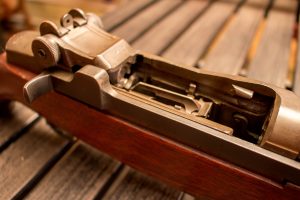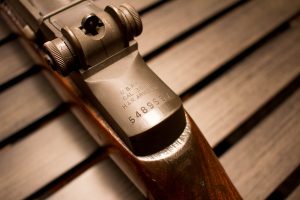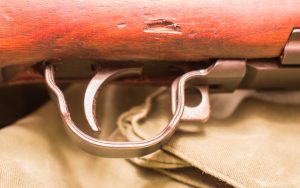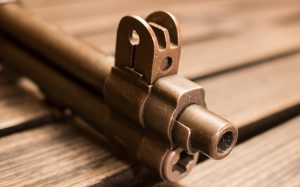The M1 Garand
In 1936, the U.S. Army’s darling rifle, the Model 1903 Springfield bolt-action, was officially replaced by what General George S. Patton described as “the greatest battle implement ever devised” — the M1 Garand. After three decades of bolt-action weapons, the Army had decided it was time to move to an auto-loading firearm, one that would give soldiers superior firepower on the battlefield.
The Garand (it actually rhymes with “errand”) used the same .30-06 Springfield ammunition that the ’03 used, but the new rifle held eight rounds, loaded all at once into the firearm by way of what is known as an “en bloc clip.” The gas-operated action actually reduced a bit of the recoil compared to that of the old Springfield 1903, even though it added a bit of weight, but the combination of more rounds and easier shooting came along just in time to serve the U.S. against its newfound enemies. Those enemies — the Axis Powers of WWII — were still issuing bolt-action rifles to their respective infantries.
One has only to fire one clip — and it is properly a “clip,” not a magazine — of rounds from a well-tuned Garand to realize exactly how wonderful John Garand’s design is. The rifle points naturally, and though heavier than, say, any one of today’s modern hunting rifles, it is well-balanced. It’s also easy to load. The eight-round en bloc clip that holds its eight cartridges is simply inserted into the top of the open receiver and then the bolt is sent home. (It is important to note that as easy as it is overall to load a Garand, one does need to be careful not to get his thumb caught in the bolt slamming closed, a syndrome known as “M1 thumb” by those painfully and unfortunately familiar with the accident).
In this video, Ashley Hlebinsky, the Robert W. Woodruff Curator at the Cody Firearms Museum, highlights the M1 Garand and gives a live fire demonstration.
In firing the Garand, when the trigger is pulled, the expanding gases from the fired cartridge are diverted to a rod that cycles the action and loads the next round. When all eight rounds have been fired, the en bloc clip is ejected with an audible “ping,” a sound Garand shooters claim to love.
- A view of the M1 Garand’s receiver in the open position.
- The rear of the M1 Garand
It is an accurate rifle. With WWII-era ammunition, I have printed (shot) groups using only the gun’s iron sights that would rival some modern scoped rifles. Of those iron sights, the rear sight is located near the back of the receiver in order to provide a long sighting radius, a key component of the accuracy equation when using only iron sights. The Garand’s also wears an external safety, which is located at the front of the trigger guard on the right side. Pulled rearward, the safety is engaged. Pushed forward the rifle can be fired.
- The trigger housing, showing the manual safety at the front.
- The front sights of the M1 Garand
The M1 Garand saw extensive duty in the second World War, the Korean War and limited use in Vietnam, winning many battles via superior firepower and its effective range – over 400 yards in the hands of a trained soldier. Discover any Garand of such vintage and you’ll note that it has a bayonet lug under the muzzle, something that allowed the soldier to effectively use the Garand even when empty. There were sniper variants, the M1C and M1D, which had telescopic sights and flash suppressors. The Navy also used a third variant of the M1, chambered in 7.62×51 NATO, the military version of our civilian .308 Winchester.
Today the Garand survives in the hands of competition shooters. The IPSC – International Practical Shooting Confederation — allows the Garand to be used in the rifle portion of its shooting matches, and the rifle makes a frequent appearance on the range in the hands of 3-Gun competitors shooting the Heavy Metal division. The M1 Garand is also used in the Service Rifle division of NRA-sanctioned High Power Rifle competition shooting, where competitors may use an M1 Garand, M1A (M14) or M16 (AR-15) rifle with original military iron sights as they shoot for score. There are some modern versions of the M1 Garand, such as the Fulton Armory M1 Service Rifle. Springfield Armory also offers more than a half-dozen up-to-date variants in its well-respected M1A series of rifle. Not up for the expense of a new one or just starting out in competing? Many surplus M1s are still available on the used gun market, and these represent a sound investment for those looking to explore today’s competitions that celebrate the effectiveness and continued usability of yesteryear’s warhorse rifle.



